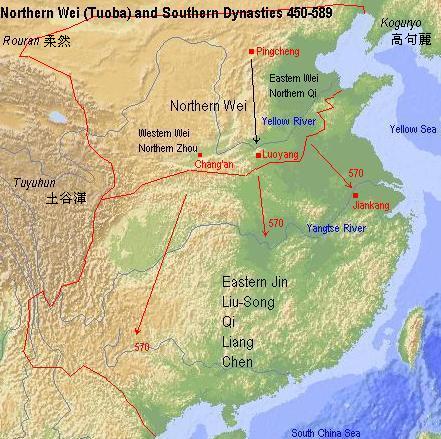
Keynotes 1
Ming1: Summing up: China's Northern Neighbors
Several peoples who lived beyond the Great Wall considerably influenced China's historical development during different periods. The most important of these peoples were
the Xiongnu, who originally settled in southern Siberia in the area of Lake Baikal and in northern Mongolia,
the Tuoba ([Western] Xianbei) who founded the Northern Wei Dynasty (CE 386-534),
the Liao Dynasty (907 - 1125),
the Jin Dynasty (1115 - 1234),
the Mongol Yuan Dynasty (1279-1368),
and the Manchu Qing Dynasty (1644-1911)
The Xiongnu are known to us through the Han Dynasty historian Sima Qian's (145?-90? BCE) records. Archaeological excavations since the 1920s have brought Xiongnu artefacts to daylight that are interpreted controversially: While some scholars relate the Ordos bronze culture associated with the Xiongnu to other cultures found in the Eurasian steppe, some Chinese archaeologists follow Sima Qian's interpretation who sees the Xiongnu as the descendants of the Xia Dynasty, the first dynastic rule of China secured by archaeological evidence. A tribal confederation of the Xiongnu was founded in 209 BCE and dominated the settlers of other peoples of the northern steppe. The Xiongnu were defeated by the Han in 119 BCE. After their subjugation their power decreased and their empire was finally divided in CE 49.

The end of the Han Dynasty in 220 CE was followed by a period of disunion which came to an end when in northern China the Tuoba Xianbei founded the Northern Wei Dynasty in 386, famous for an extensive patronage of Buddhism. The History of the Wei Dynasty (Weishu) relates the origins of the Tuoba to Changyi, one of the sons of the Chinese mythical Yellow emperor. But there is no archaelological evidence to prove the record. Instead, the Xianbei seem to have migrated southward from northern Manchuria to the Yellow River.

The Qidan (Khitan) and their Liao Dynasty are
first mentioned as a people settling in what today is eastern Inner Mongolia
in the records of the Northern Wei Dynasty (386-534 CE). They are regarded as
belonging to the eastern branch of the Xianbei people, yet other records related
them to the Xiongnu. They consisted of eight loosely related tribes who idependently
paid tribute to the Northern Wei and only began to form an alliance from 730
to 907. In 916 a state was established alternatingly called Liao and Qidan until
in 1066 the name remained Liao. In 1004 the Liao sucessfully attacked the Song
Dynasty. The peace treaty that was signed subsequently dictated enormous sums
of reparation payments that the Song had to pay to the Liao (200,000 bolts of
silk and 100,000 taels of silver). In archaeological excavations almost 200
Liao cities have been found, that showed the significant influence of Chinese
architecture and culture of the Tang Dynasty in Liao culture. When building
their cities and equipping their palaces the Liao had exploited Chinese craftsmen
on a large scale. Unique for Liao culture are funerary masks which are interpreted
as related to shamanistic beliefs that were supposed to aid the deceased in
the netherworld.

The Nuzhen or Jurchen are first mentioned as a people in documents of the Later Tang Dynasty (923-936) and are believed to have originated south of the Amur river in Manchuria. The Jurchen, who founded the Jin Dynasty conquered Liao territory in a rebellion against the Liao. When the Song attempted to regain their former territory which had been captured by the Liao, the Jin turned against the Song, conquered in addition the northern part of Song territory, and claimed that the payments once delivered to the Liao were now due to be delivered to their own court. They plundered the Song Kapital of Kaifeng in 1127 and subsequently China became divided into the northern part ruled by the Jin Dynasty and the Southern Song territory with Hangzhou as the new capital.
Rebelling against the Jin, under whose suzerainty they had lived, the Mongols crossed north China in 1214. The Mongol Yuan Dynasty was founded in 1260 by Khubilai Khan. The Mongol army first conquered northern China, and during the subsequent decades occupied the entire Chinese realm down to the southern and southeastern coast.
The Yuan were driven away from Chinese territory by Chinese patriotic rebels in 1368. One of the successful rebel leaders founded the Chinese Ming Dynasty which lasted for almost 300 years.

When the Ming became weak, the Manchu Qing Dynasty invaded China and took over central and local power throughout the country until the final days of imperial China.
